Eighty per cent of the energy consumption in EU buildings comes from heating and cooling. Reducing how much energy we use and changing what sources it comes from will impact wellbeing and the quality of life in our homes, offices and public buildings. With a full set of Green Deal policies on the table, it is up to political leaders across Member States and the European Parliament to preserve, improve and integrate proposals. These are the three main areas that need their attention.
Take a decisive step towards clean heat
The move towards clean heat requires further integration across policy proposals. The Energy Efficiency, Directive and Energy Performance of Buildings and Renewable Energy Directives include provisions to limit fossil fuel use and drive up the share of renewable heat in buildings, which can be strengthened. At the same time, the Gas Package falls significantly short of providing a clear and manageable path towards gas usage decline. Finding the political will to improve proposals is critical, given that today only 21 per cent of heating energy in the EU is produced by renewables.
The electrification of heat, including heat pump-powered district heating, can be the cheapest option for consumers across countries as varied as the Czech Republic, Poland, Italy and Germany. Switching to clean alternatives can also be an excellent macroeconomic choice. The European Commission reports that the added value of clean energy systems has grown faster than the rest of the economy over the last ten years, reaching the value of €188bn in 2019. The global shift away from coal, oil and gas boilers is also on the go, with sales declining steadily from 59% of heating technologies in 2010 to 48% in 2020.
Unlock the potential of local engagement
Policies to decarbonise heating and cooling will meet everyday life in regions, neighbourhoods and communities across Europe. So the clean energy transition will not happen without the support and participation of ordinary people. The Energy Efficiency Directive makes positive steps to encourage such engagement. Key elements include new provisions to develop local heating and cooling plans, support independent advice services for citizens, and invest in project development assistance.
At this stage of the legislative process, both the French presidency of the European Council and the European Parliament seek to preserve key aspects of the proposal. Over a billion euros is available for technical assistance as part of the EU budget, and well-established formal venues exist to exchange best practices on implementing the energy efficiency, buildings and renewables directives. For example, the Netherlands may be well placed to champion local planning approaches, building on its domestic efforts to develop district-oriented approaches to switch to clean heat.
Rebalance economic incentives while protecting the vulnerable
Rebalancing the costs of clean and fossil-fuel heating technologies is by far the most politically challenging element of proposals tabled by the European Commission. There are two policy options to change the pricing of fuels under discussion. One is the extension of the Emissions Trading System to the transport and heating sectors. The other one is the revision of the Energy Taxation Directive. Both tools can help create economic incentives to speed up buildings renovation and fuel switching. However, they require detailed assessment, careful design and extensive social policy to support and safeguard citizens, especially those in or at risk of energy poverty.
Most countries have experience designing carbon policies and measures to manage their impact. The use of explicit carbon taxes has doubled over the last 14 years, rising from seven countries in 2008 to 14 today. At the same time, member states provided an average of €55-58 bn per year in fossil fuel subsidies, mainly in the form of tax exemptions or tax reductions. In addition, the European Green Deal provides over a trillion euros of public funding. These funds could be useful to support citizens and invest in the skills and supply chains of the future.
Political and business leaders in the EU are not starting from scratch. They have a unique opportunity to combine existing policies and experience to deliver a solid transition to clean heating and cooling in buildings. It’s time to unleash the full potential of buildings renovation to improve people’s lives and move the whole energy transition forward.
This blog is part of a blog series:


